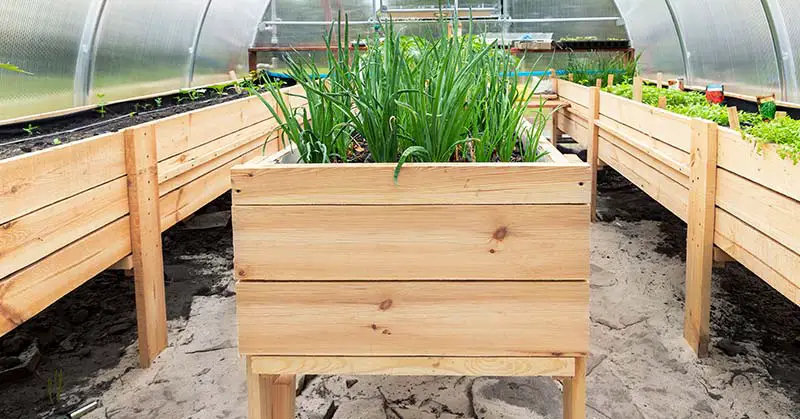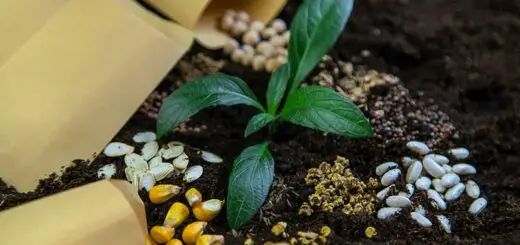Creating a Raised Garden Bed from Pallets
Creating a raised garden bed from pallets is a fun and rewarding DIY project with numerous benefits for your gardening needs. This sustainable approach to gardening promotes plant health, improves soil conditions, and adds a unique aesthetic appeal to your outdoor space.
So whether you’re a seasoned gardener looking for a new challenge or a beginner seeking a cost-effective way to start your horticulture journey, crafting a raised garden bed from pallets could be your next great adventure.
The concept of raised garden beds is familiar; they have been used for centuries to grow various plants. However, using pallets in these beds brings a fresh, sustainable perspective to the traditional method. Pallets are often discarded after a single use, leading to unnecessary waste.
By repurposing them for our garden beds, we can reduce this waste and give these sturdy structures a second life, promoting a more sustainable lifestyle.
The appeal of a raised garden bed from pallets lies in its accessibility and potential for customization. Regardless of your space, soil quality, or personal style, a raised bed from pallets can be designed to fit your needs.
Join us as we delve into this topic, offering step-by-step guidance on sourcing, preparing, and constructing your raised garden bed from pallets.

Advantages of Using Raised Garden Beds
Raised garden beds have several benefits that can significantly enhance your gardening experience. Here are some of the key advantages of using raised garden beds:
Improved Soil Conditions: Raised garden beds allow complete control over the soil used, meaning you can select the ideal soil mix for your plants. This is particularly beneficial if your garden has poor or heavy clay soil.
Over time, soil in raised beds also stays loose and well-drained due to the lack of soil compaction from walking around the plants, which encourages healthy root growth.
Better Pest and Weed Control: With the added height, raised beds can deter some pests like rabbits and can minimize the spread of soil-borne diseases. Adding barriers or netting around raised beds is also easier if necessary.
Additionally, since you’re filling the bed with fresh soil, you’ll likely have fewer issues with weeds.
Extended Growing Season: The soil in raised garden beds warms up faster in the spring and stays warm longer into the fall, extending the growing season. This can be particularly beneficial for plants that need a long warm period to produce, like tomatoes or peppers.
Easier Accessibility: Raised beds are easier to reach, which makes all aspects of gardening—from planting and weeding to watering and harvesting—more accessible. This can be especially beneficial for older adults or individuals with mobility issues, as it reduces the need for bending and kneeling.
Efficient Use of Space: Raised beds are often easier to manage than an entire garden, and you can continually grow more plants in less space due to improved soil and weed control. The raised bed layout encourages a planned, efficient setup and can easily be incorporated into the landscape design.
Enhanced Aesthetic Appeal: Raised garden beds add structure to your garden, help organize your plantings, and can become a design feature. Various designs are available, from simple and functional to highly ornamental, to suit any garden style.
By combining these advantages with the environmental benefits of using repurposed materials like pallets, you can create an attractive, productive, and sustainable garden bed with relative ease.
Benefits of Upcycling Pallets for this Project
Upcycling pallets to create a raised garden bed is not only a great way to repurpose used materials but also offers numerous benefits:
Cost-Effective: Pallets are often readily available, inexpensive, or even free. This makes them more cost-effective for building raised garden beds than buying new lumber or pre-made kits.
Sustainability: Reusing pallets reduces waste that would otherwise end up in landfills. Upcycling pallets is a great way to promote sustainability and participate in the circular economy.
Versatility: Pallets can be disassembled, and their planks can be cut and rearranged in countless ways, making them incredibly versatile. This means you can create a raised garden bed in almost any shape or size.
Durability: Pallets are designed to hold heavy loads and withstand rough handling, so they’re typically sturdy and durable. When treated correctly, a pallet garden bed can last for several years.
Unique Aesthetic: The rustic pallet wood look can add a unique, charming aesthetic to your garden. Each pallet has its character and, over time, will develop a naturally weathered appearance that can enhance the beauty of your outdoor space.
Skill Development: The process of upcycling pallets for a project like this can help you develop helpful DIY skills. These include everything from safely dismantling a pallet to learning basic construction techniques.
Sustainability and Versatility of Pallets
Pallets are popular for many DIY projects, and it’s easy to see why. They are both sustainable and versatile, ideal for various uses, including constructing raised garden beds.
Sustainability of Pallets:
Reduce Waste: Many businesses have excess pallets they do not need and want to dispose of. By repurposing these pallets, you help to reduce waste and contribute to a more circular economy.
Repurposing Over Recycling: While pallets can be recycled, upcycling them into something useful, like a garden bed, often requires less energy and resources than recycling. This reduces the environmental impact and promotes sustainability.
Longevity: Pallets are designed to be sturdy and durable, meaning a garden bed made from pallets can last several years, reducing the need for replacement and the associated resource use.
Versatility of Pallets:
Design Flexibility: Pallets can be disassembled and reassembled in various ways, offering great flexibility in terms of design. Whether you’re building a simple square bed or a more complex multi-tiered design, pallets can accommodate your needs.
Ideal Size: The size of pallet planks is usually suitable for constructing raised garden beds. This reduces the need for cutting and resizing, simplifying the construction process.
Natural Aesthetic: The rustic look of pallet wood adds a charming touch to garden spaces. Each pallet has its unique characteristics, adding individuality to your project.
Skill Building: Working with pallets can help you develop valuable DIY skills. This includes safely disassembling a pallet, treating and preparing the wood, and using basic construction techniques.
When choosing to work with pallets, ensuring they are safe to use is essential. Look for pallets that have yet to be chemically treated, as these could leach harmful substances into your soil.
Preferentially, look for pallets marked with “HT” which stands for heat-treated, a safe method for treating wood. Finally, always source pallets responsibly, prioritizing those that would otherwise be discarded or sent to landfill.
Required Materials and Tools
Creating a raised garden bed from pallets is a straightforward process that requires a few key materials and tools. Below is a comprehensive list to help you gather everything you’ll need before starting your project:
Materials:
Pallets: The number of pallets needed will depend on the size of your garden bed. Generally, 2-4 pallets are enough for a standard-sized bed. Ensure the pallets are safe for use (i.e., heat-treated and not chemically treated).
Landscape Fabric: This will line the inside of your garden bed to prevent soil from falling out and to discourage weeds and pests.
Screws: Choose outdoor, weather-resistant screws to ensure your raised bed holds together well over time.
Soil and Compost: You’ll need a good mix of topsoil, compost, and other organic matter to fill your garden bed and provide plant nutrients.
Plants or Seeds: Depending on your preference, you can start with seeds or seedlings for your garden bed.
Tools:
Hammer or Pry Bar: To disassemble the pallets.
Saw: If you must cut the pallet wood to fit your garden bed design.
Power Drill: To assemble the pallet planks into a bed. A screwdriver can also work, but a drill will make the process quicker and easier.
Measuring Tape: To measure and mark where you need to cut.
Staple Gun: To secure the landscape fabric inside the bed.
Gloves: To protect your hands during construction and gardening.
Wheelbarrow: For mixing and moving your soil.
Choosing the Perfect Pallet
Choosing the right pallet for your garden bed project is crucial for safety and functionality. Here are some guidelines on how to choose the best pallet for your raised garden bed:
Check for the Pallet Marking
Look for the International Plant Protection Convention (IPPC) logo. This logo indicates that the pallet meets international safety regulations. In addition, there should be letters next to the IPCC logo showing how the pallet was treated:
HT: Heat Treated – These pallets are safe to use. They have been treated with heat rather than chemicals to kill any pests in the wood.
MB: Methyl Bromide – Avoid these pallets. They have been fumigated with a pesticide that can be harmful.
DB: Debarked – This means the bark has been removed. Check for other symbols (HT or MB) to know if they’re safe.
Choose a Clean, Untreated Pallet
Avoid pallets that appear stained or painted, as these treatments could contain harmful chemicals. Also, look for clean pallets free of spills, mold, or infestations.
Check the Condition of the Pallet
Look for pallets in good condition. The wood should be free of rot and not overly cracked or broken. This will ensure your raised bed lasts for several years.
Consider the Size
Depending on your design, the size of the pallet may matter. Standard pallets are usually 48 x 40 inches, but sizes can vary. Measure the area where you plan to put the garden bed and consider how many pallets you’ll need based on that and their size.
Source Ethically
Always source pallets responsibly. Many businesses have leftover pallets but ask before taking them. Some companies reuse their pallets, and taking pallets without permission in some areas might be illegal.
Step-by-step Guide to Building a Raised Garden Bed from Pallets
Let’s walk through building a raised garden bed from pallets.
Step 1: Planning and Designing Your Garden Bed
Start by deciding the size and location of your raised garden bed. Remember the number of pallets you have and the space required for the plants you want to grow.
Step 2: Preparing Your Pallets
Inspect the pallets to ensure they’re safe to use (look for the “HT” mark and avoid painted or stained pallets).
Clean your pallets by scrubbing them with a brush to remove dirt or debris, then let them dry.
Step 3: Dismantling the Pallets
Use a hammer or pry bar to carefully remove the planks from the pallets. Be careful to remove any nails or staples safely.
Step 4: Building the Garden Bed Structure
Arrange your planks to form the four sides of your garden bed. You can cut some planks to size depending on your design.
Use a drill to secure the corners of the bed together with screws. Make sure the structure is sturdy and even.
Step 5: Lining the Garden Bed
Line the inside of your bed with landscape fabric. This will keep the soil in place and discourage weeds from growing.
Use a staple gun to secure the fabric, ensuring it covers the bottom and sides of your bed.
Step 6: Positioning Your Bed
Once the bed is built, move it to its final location. Remember, it’s easier to move before it’s filled!
Step 7: Adding the Soil
Mix your soil and compost in a wheelbarrow or directly in the bed.
Fill your raised garden bed with the soil mixture, leveling the surface.
Step 8: Planting
Now comes the fun part! Plant your seeds or seedlings according to their specific needs.
Remember to leave enough space between the plants for growth and consider their sunlight and watering needs.
Step 9: Watering and Care
Thoroughly water your new garden and continue to care for your plants as they grow.
Regularly check on your plants, remove any weeds that appear, and replace nutrients in the soil as needed.
Tips for Maintaining Your Pallet Garden Bed
Maintaining a raised garden bed made from pallets is much like caring for any other type of garden, but there are some specific tips to keep in mind:
Regular Watering: Depending on what you’re growing, you may need to water your garden daily, especially in hot weather. However, be careful not to overwater. Raised beds can drain faster than regular gardens, so the soil should be moist but not soaked.
Mulching: Consider adding a layer of mulch to the top of your soil. This can help to conserve moisture, suppress weeds, and add organic matter to the soil as it breaks down over time.
Checking for Pests: Regularly inspect your plants for signs of pests or diseases. Due to the raised design, it may be easier to spot potential issues early on. Remove any unhealthy plants or treat them as necessary.
Fertilizing: The nutrients in the soil of a raised garden bed can be depleted over time. Consider using compost or natural fertilizer to add nutrients to the soil. This can be done at the beginning of each new growing season.
Rotating Crops: Consider practicing crop rotation. This means changing the type of plants you grow in the bed from one season to the next. This can help prevent the build-up of specific plant diseases and pests and help maintain a balance of nutrients in the soil.
Winter Care: Depending on your climate, add a layer of compost or mulch to the bed in the fall to prepare for winter. This can help protect perennial plants and enrich the soil for the next growing season.
Maintaining the Bed Structure: Inspect the bed regularly for any signs of wear or damage. The wooden planks may weather and age over time, which can add to their rustic charm.
However, if any planks become rotten or damaged, you may need to replace them to maintain the bed’s structural integrity.
Final Thoughts
Building a raised garden bed from upcycled pallets is an achievable and rewarding DIY project with numerous benefits. The process allows you to contribute to sustainability actively and offers a cost-effective way to enhance your garden.
A raised bed improves soil conditions, extends the growing season, and makes gardening more accessible. Choosing the perfect pallet, gathering the necessary materials and tools, and following a clear step-by-step guide are key to successful construction.
With proper care and maintenance, your pallet garden bed can serve you for many growing seasons, providing a fertile home for various plants and adding rustic charm to your outdoor space. The journey from pallet to a garden bed is not just a transformation of materials but also a testament to the incredible potential of upcycling.



